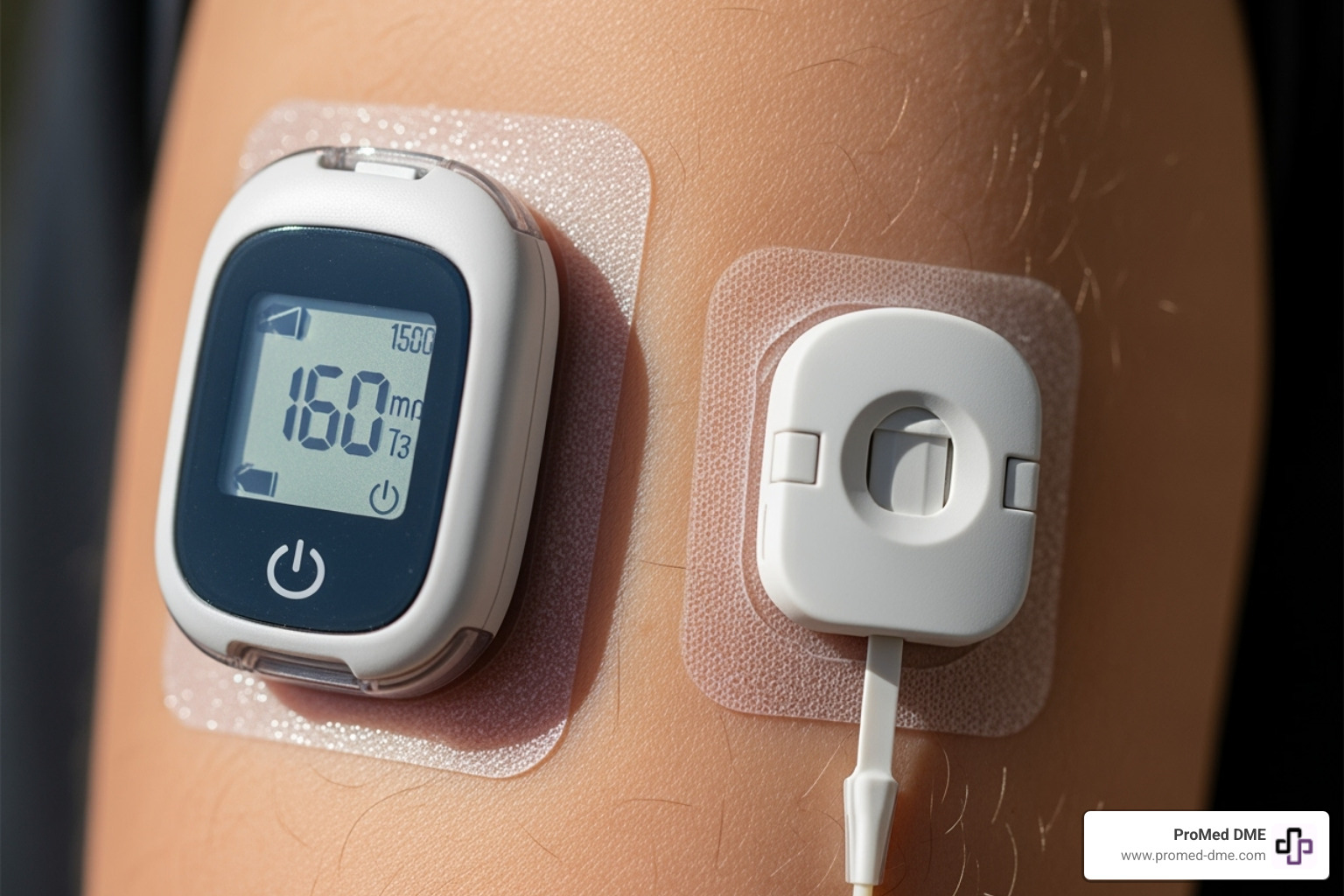Gestational Diabetes Got You Down? CGM to the Rescue!

Why CGM for Gestational Diabetes is a Game-Changer
CGM for gestational diabetes offers pregnant women continuous blood sugar monitoring that can reduce complications like macrosomia by up to 5.6 times compared to traditional finger-stick testing. Here's what you need to know:
Quick Benefits Overview:
- Real-time alerts prevent dangerous blood sugar spikes
- Reduced baby complications - 20% vs 4.1% macrosomia risk in studies
- Less finger pricking - continuous monitoring vs 4-8 daily tests
- Better outcomes - 0.22% average HbA1c improvement
- Catches hidden highs that finger-sticks miss, especially at night
Getting a gestational diabetes diagnosis can feel overwhelming. As one recent study noted, "Gestational diabetes can feel stressful and even scary, but with guidance from your doctor and the right habits and tools, it can be managed."
The numbers back this up. The number of women with gestational diabetes has doubled in the past 15 years, making better monitoring tools more important than ever.
Traditional finger-stick testing only gives you snapshots - like checking your speed once every few hours on a long road trip. CGM is like having a continuous speedometer for your blood sugar. It measures glucose in your tissue fluid every 1-5 minutes, sending data straight to your phone.
This matters because gestational diabetes affects both you and your baby. Uncontrolled blood sugar can lead to larger babies (macrosomia), breathing problems, and NICU stays. But with CGM, you get the data you need to keep both of you healthy.

How Continuous Glucose Monitoring Works Inside a Pregnant Body
Picture a tiny guardian angel sitting just under your skin, watching over your blood sugar 24/7. That's essentially what your CGM for gestational diabetes does - it never takes a break from keeping you and your baby safe.
The magic happens in your interstitial fluid, the watery layer that surrounds all your cells. Your CGM sensor sits right in this fluid, using a hair-thin filament to measure glucose levels every few minutes.
The sensor works through a clever chemical reaction. It's coated with glucose oxidase, an enzyme that gets excited when it meets glucose. The more glucose around, the stronger the electrical signal it creates. This signal gets sent to your phone or receiver, giving you real-time data about what's happening inside your body.
The Science Behind the Sensor
Here's where pregnancy makes things really interesting. Your body is working overtime right now, especially in the second and third trimesters when insulin resistance naturally kicks in. Your pancreas has to work much harder to keep blood sugar levels normal during pregnancy.
The sensor measures glucose in your interstitial fluid, which has about a 5-10 minute lag time compared to blood glucose. This gives you advance warning of where your blood sugar is heading, not just where it is right now. Those trend arrows on your screen become your crystal ball, showing whether your glucose is climbing, dropping, or staying steady.
Accuracy & Safety in Expectant Moms
Let's talk about what matters most - keeping you and your baby safe. Modern CGM systems are FDA-approved for use during pregnancy and have been studied extensively in expectant mothers.
The landmark CONCEPTT trial followed 325 pregnant women with diabetes and found no safety red flags. Scientific research on pregnancy CGM accuracy shows that women using CGM had better glucose control and fewer complications than those relying on finger-stick testing alone.
When it comes to accuracy, today's CGM systems achieve a Mean Absolute Relative Difference (MARD) of 8-10% during pregnancy. This accuracy holds steady throughout your pregnancy, even as your body goes through all its amazing changes.
Skin reactions are the most common concern, but serious problems are rare. About 1-2% of users experience skin irritation, which usually clears up by rotating sensor locations.
CGM vs. Finger-Sticks: Why the Upgrade Matters
If you've been diagnosed with gestational diabetes, you've probably already experienced the reality of finger-stick testing. Pricking your fingers 4-8 times a day gets old fast - and that's just the beginning of why CGM for gestational diabetes is such a game-changer.
Think about it this way: traditional finger-stick testing is like checking your car's speed once every few hours on a long road trip. CGM is like having a continuous speedometer - it gives you 288+ readings per day instead of just a handful of snapshots.
The difference is dramatic. While you're sleeping peacefully, your blood sugar might be quietly spiking or dropping to dangerous levels. Traditional testing misses 60% of low blood sugar episodes that happen overnight. CGM catches these hidden patterns and can wake you up with gentle alerts before things get serious.
Research backs up what many women experience firsthand. CGM users spend 68% of their time in the target glucose range compared to 61% with traditional testing. That 7% difference translates to significantly better outcomes for both you and your baby.
What Makes CGM for Gestational Diabetes Accurate and Safe?
Pregnancy creates predictable patterns in blood sugar that CGM captures beautifully. Most women notice their highest readings after breakfast and their lowest readings overnight. CGM for gestational diabetes works particularly well because it reveals these patterns in stunning detail.
The data density is incredible - imagine having a glucose reading every 3 minutes throughout your entire pregnancy versus just a few snapshots per day. This comprehensive picture helps you and your healthcare team make smarter decisions about meal timing, exercise, and medication adjustments.
Trend arrows become your best friend during pregnancy. They give you advance warning about where your blood sugar is heading, not just where it is right now. This predictive power is especially valuable when you're managing the unpredictable appetite changes that come with pregnancy.
CGM for Gestational Diabetes Beats SMBG on Outcomes
The research tells a compelling story. In the FLAMINGO study, women using intermittent CGM had dramatically lower rates of macrosomia - 4.1% compared to 20% in the traditional testing group. That's a five-fold reduction in the risk of having a baby that's too large for safe delivery.
Other major studies show similar benefits. The CONCEPTT trial found a 53% reduction in large-for-gestational-age babies among CGM users. There were also 28% fewer cases of neonatal hypoglycemia and significantly fewer NICU admissions.
But the benefits go beyond just medical outcomes. Maternal stress and anxiety levels drop significantly when women can see their blood sugar patterns in real-time. Instead of wondering what your blood sugar is doing between finger-stick tests, you have continuous peace of mind.

Proven Benefits & Official Guidelines on CGM for Gestational Diabetes
The medical evidence is in, and it's compelling. CGM for gestational diabetes has moved from "nice to have" to "strongly recommended" by major medical organizations. The American Diabetes Association made this shift official in their 2023 guidelines, now recommending CGM for all pregnant women with diabetes - including those with gestational diabetes.
The FLAMINGO study really opened eyes in the medical community. Researchers found that those using intermittent CGM had 5.6 times lower odds of having a large baby (macrosomia). Even more impressive? They only used CGM for about 4 weeks after diagnosis, not the entire pregnancy.
When researchers combined data from six different studies involving 482 women with gestational diabetes, they found consistent benefits across the board. Women using CGM saw an average 0.22% reduction in HbA1c levels. That might not sound like much, but in diabetes management, every tenth of a percent matters for your baby's health.
The pregnancy targets are tighter than what you'd see for regular diabetes management. Scientific research on guideline targets shows that most guidelines now recommend spending more than 70% of your time in the target range of 70-140 mg/dL.
You'll also want to keep time above 140 mg/dL to less than 25% and time below 70 mg/dL to less than 4%. These targets might seem strict, but they're based on extensive research showing that tighter control leads to healthier outcomes.
Who Benefits Most from CGM for Gestational Diabetes?
While any woman with gestational diabetes can benefit from CGM, certain groups see the most dramatic improvements.
Women on insulin see the biggest benefits. Managing insulin during pregnancy is like trying to hit a moving target, and CGM acts like a safety net, catching problems before they become serious.
Women managing their diabetes with diet alone also see significant benefits. CGM reveals hidden spikes after meals that finger-stick testing would miss entirely. Many women find they need to adjust their eating patterns based on what CGM shows them.
Women with higher BMI (over 30) tend to see particularly dramatic improvements. One study found a 40% reduction in complications when these women used CGM compared to traditional testing.
If you've had gestational diabetes before, are carrying twins or triplets, or have a family history of diabetes, you're also likely to see significant benefits from CGM monitoring.
Intermittent vs Continuous Wear Strategies
Here's some good news: you don't necessarily need to wear CGM for your entire pregnancy to see benefits. The research shows that strategic, intermittent use can be just as effective for many women.
The intermittent approach involves wearing CGM for 2-4 week periods - typically right after diagnosis and then again if your control needs fine-tuning. This approach is more cost-effective and still provides the crucial data you need.
The continuous approach means wearing CGM throughout your pregnancy from diagnosis to delivery. This makes the most sense if you're using insulin, have had complications, or fall into one of the higher-risk categories.
At ProMed DME, our dedicated nurse works with you and your healthcare team to determine the best approach for your specific situation.
Practical How-To: Getting the Most from Your Pregnancy CGM

Starting with CGM for gestational diabetes doesn't have to feel intimidating. Think of it like learning to use a new smartphone - a little overwhelming at first, but soon it becomes second nature.
Sensor placement is easier than you might think. The back of your upper arm is the sweet spot. Clean the area with alcohol and let it dry completely. The applicator does most of the work for you with a quick click, and you're done in seconds.
Site rotation matters more during pregnancy because your skin becomes more sensitive. Alternate between arms with each new sensor, and avoid areas where your clothes might rub.
Customizing your alerts is where CGM really shines. Set your high alert around 140 mg/dL (or whatever your doctor recommends), and if you're on insulin, keep that low alert at 70 mg/dL.
The daily routine becomes surprisingly simple once you get into the groove. Meal logging helps you spot patterns - note when you eat and roughly how many carbs you had. Exercise timing gets logged too, along with any medications.
Don't forget about ketone checks. During pregnancy, ketones can develop quickly, especially if you're not eating enough carbs or if you're sick.
Turning CGM Data into Action
Raw numbers on your phone screen are just the beginning. The real magic happens when you start connecting the dots between your glucose readings and your daily life.
Meal management becomes so much clearer with CGM. You'll quickly learn which foods send your glucose soaring and which ones keep you steady. That morning bowl of cereal might look innocent, but if your CGM shows a spike to 180 mg/dL afterward, you'll know to switch to something with more protein and fiber.
Exercise timing is another game-changer. A 10-minute walk after dinner might drop your glucose from 150 to 120 mg/dL. Once you see this pattern a few times, you'll start planning those post-meal walks automatically.
Sleep patterns tell their own story through CGM data. You might notice your glucose creeping up around 4 AM (hello, dawn phenomenon) or dropping too low in the early morning hours.
Provider communication becomes so much more productive when you have real data to share. Download those reports before your appointments - your doctor will love seeing the complete picture.
Insurance, Costs & Reimbursement Hacks

Let's be real about the money side of things. CGM sensors can cost $70-90 each without insurance, and they need replacing every 10-14 days.
The good news? Most insurance plans now cover CGM for gestational diabetes, particularly if you're on insulin. Your diagnosis code (O24.4 for gestational diabetes) combined with documentation of frequent blood sugar testing usually does the trick.
Prior authorization can feel like jumping through hoops, but it's worth the effort. Your doctor needs to document why CGM is medically necessary for your specific situation.
At ProMed DME, we've seen every insurance scenario imaginable. Our team specializes in working with insurance companies to get you the supplies you need without the headaches. We handle all the paperwork, follow up on claims, and fight denials so you don't have to. Free shipping nationwide means your sensors arrive at your door.
Our dedicated nurse is available to answer questions about your CGM setup, insurance coverage, or anything else related to your diabetes supplies.
Frequently Asked Questions about CGM for Gestational Diabetes
Is CGM safe for my baby?
This is probably the first question on your mind, and we completely understand. The short answer is yes - CGM for gestational diabetes is absolutely safe for both you and your baby.
The FDA has approved CGM sensors specifically for use during pregnancy, and they've been put through rigorous testing. The CONCEPTT trial, which followed 325 pregnant women using CGM throughout their pregnancies, found zero safety concerns for mothers or babies.
Here's what makes CGM safe: the sensor sits just under your skin - think of it like a tiny splinter that doesn't hurt. It doesn't go anywhere near your baby or your bloodstream. The materials are biocompatible, which means they're designed to work safely with your body for weeks at a time.
Some women worry about the electrical signal from the sensor, but it's incredibly weak - thousands of times weaker than your cell phone. The signal doesn't travel beyond the immediate sensor area, so there's no way it could affect your baby.
Do I still need lab glucose tests?
Yes, you'll still need some finger-stick testing, but way less than before. Think of CGM as your main monitoring system with traditional testing as your backup.
Your healthcare team will still want confirmation of CGM readings when they're making important decisions about your care. If your doctor is considering starting you on insulin or changing your dose, they'll likely want to see a finger-stick reading to confirm what your CGM is showing.
You'll also need backup testing if your sensor gives you a reading that doesn't match how you feel. If your CGM says you're low but you feel fine, a quick finger-stick can tell you what's really happening.
Ketone testing is still important too, especially if you're sick or your blood sugar is running high. CGM doesn't measure ketones, so you'll need traditional test strips for that.
The good news? Instead of testing 4-8 times a day, you might only need to test a few times a week for confirmation.
Will insurance cover the sensors?
Most insurance plans now cover CGM for gestational diabetes, especially when your doctor documents why you need it. Coverage has improved dramatically over the past few years as more research shows how effective CGM is for pregnancy outcomes.
Typical coverage includes the sensors themselves (usually covered as durable medical equipment), transmitters with prior authorization, and sometimes even the receiver (though most people just use their smartphones).
The key is proper documentation. Your doctor needs to show that you have gestational diabetes, that you're testing your blood sugar frequently, and that CGM will help you manage your condition better. If you're on insulin, approval is usually much easier since the medical necessity is clear.
At ProMed DME, we handle all the insurance paperwork for you. Our team knows exactly what insurance companies want to see, and we'll work directly with your doctor's office to get the prior authorization submitted correctly the first time. We follow up on claims, handle appeals if needed, and fight denials so you don't have to.
We work with most insurance plans and offer free shipping nationwide. Our dedicated nurse is always available to answer questions about your coverage or help you understand your benefits.
Conclusion
You've made it through your gestational diabetes journey, and now you know that CGM for gestational diabetes isn't just another medical device - it's your partner in creating the healthiest possible start for your baby.
Think about it: instead of guessing what your blood sugar is doing between those painful finger sticks, you'll have a complete picture. The real-time data takes the guesswork out of managing your condition.
The research speaks for itself. Women using CGM see dramatically better outcomes - we're talking about cutting the risk of having a large baby by more than five times. That's not just a statistic; that's potentially avoiding a difficult delivery, a NICU stay, or breathing problems for your little one.
But beyond the medical benefits, there's something equally important: peace of mind. When you can see your glucose trends on your phone, when you get gentle alerts before problems develop, when you have months of data to share with your healthcare team - that's empowerment.
At ProMed DME, we've seen hundreds of women transform their gestational diabetes management with CGM. Our dedicated nurse has walked countless expectant mothers through their first sensor application, answered questions about confusing readings, and celebrated with families when their babies arrive healthy and strong.
We know the insurance maze can be frustrating, especially when you're dealing with pregnancy fatigue and doctor appointments. That's why we handle the paperwork, fight the denials, and work directly with your insurance company. Our team has gotten approvals for women who were initially denied, and we've helped families access CGM technology they thought they couldn't afford.
The technology that seemed impossible just a few years ago is now available, proven, and accessible. You have better tools, better support, and better outcomes waiting for you.
Your baby deserves the healthiest start possible, and you deserve to feel confident about providing it. CGM for gestational diabetes gives you both. The path forward is clear, the support is real, and the results speak for themselves.
Ready to take the next step? Your healthy pregnancy journey starts with a simple phone call to our team. We'll check your insurance, answer your questions, and get you started with the technology that's changing lives - one healthy baby at a time.
Related Resources & Articles
Stay informed with our informative blog posts.
Discover the ProMed Advantage
& Try Our Products
We offer free shipping and legendary customer service to ensure you receive the
best DME products for your needs.



